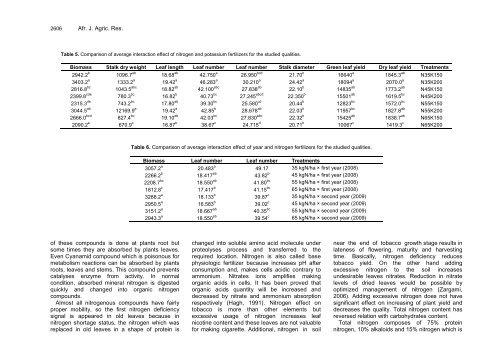Download Complete Issue - Academic Journals
Download Complete Issue - Academic Journals
Download Complete Issue - Academic Journals
Create successful ePaper yourself
Turn your PDF publications into a flip-book with our unique Google optimized e-Paper software.
2606 Afr. J. Agric. Res.<br />
Table 5. Comparison of average interaction effect of nitrogen and potassium fertilizers for the studied qualities.<br />
Biomass Stalk dry weight Leaf length Leaf number Leaf number Stalk diameter Green leaf yield Dry leaf yield Treatments<br />
2942.2 b 1096.7 ab 18.68 ab 42.750 a 26.950 bcd 21.70 b 16640 a 1845.3 ab N35K150<br />
3403.2 a 1333.2 a 19.42 a 46.283 a 30.210 a 24.42 a 18094 a 2070.0 a N35K200<br />
2816.8 bc 1043.5 abc 18.82 ab 42.100 abc 27.838 ab 22.10 b 14835 ab 1773.2 ab N45K150<br />
2399.8 cde 780.3 bc 16.82 b 40.73 bc 27.245 abcd 22.350 b 15501 ab 1619.5 bc N45K200<br />
2315.3 de 743.2 bc 17.80 ab 39.30 bc 25.580 cd 20.44 b 12823 bc 1572.0 bc N55K150<br />
3044.5 ab 12169.9 a 19.42 a 42.85 b 28.678 ab 22.03 b 11957 bc 1827.8 ab N55K200<br />
2666.0 bcd 827.4 bc 19.10 ab 42.03 bc 27.830 abc 22.32 b 15425 ab 1838.7 ab N65K150<br />
2090.2 e 670.9 c 16.87 b 38.67 c 24.715 d 20.71 b 10067 c 1419.3 c N65K200<br />
of these compounds is done at plants root but<br />
some times they are absorbed by plants leaves.<br />
Even Cyanamid compound which is poisonous for<br />
metabolism reactions can be absorbed by plants<br />
roots, leaves and stems. This compound prevents<br />
catalyses enzyme from activity. In normal<br />
condition, absorbed mineral nitrogen is digested<br />
quickly and changed into organic nitrogen<br />
compounds.<br />
Almost all nitrogenous compounds have fairly<br />
proper mobility, so the first nitrogen deficiency<br />
signal is appeared in old leaves because in<br />
nitrogen shortage status, the nitrogen which was<br />
replaced in old leaves in a shape of protein is<br />
Table 6. Comparison of average interaction effect of year and nitrogen fertilizers for the studied qualities.<br />
Biomass Leaf number Leaf number Treatments<br />
3057.2 a 20.483 a 49.17 35 kgN/ha × first year (2008)<br />
2266.2 b 18.417 ab 43.82 b 45 kgN/ha × first year (2008)<br />
2208.7 bc 18.550 ab 41.80 bc 55 kgN/ha × first year (2008)<br />
1812.8 c 17.417 b 41.15 bc 65 kgN/ha × first year (2008)<br />
3288.2 a 18.133 b 39.87 c 35 kgN/ha × second year (2009)<br />
2950.5 a 16.583 b 39.02 c 45 kgN/ha × second year (2009)<br />
3151.2 a 18.667 ab 40.35 bc 55 kgN/ha × second year (2009)<br />
2943.3 a 18.550 ab 39.54 c 65 kgN/ha × second year (2009)<br />
changed into soluble amino acid molecule under<br />
proteolyses process and transferred to the<br />
required location. Nitrogen is also called base<br />
physiologic fertilizer because increases pH after<br />
consumption and, makes cells acidic contrary to<br />
ammonium. Nitrates ions amplifies making<br />
organic acids in cells. It has been proved that<br />
organic acids quantity will be increased and<br />
decreased by nitrate and ammonium absorption<br />
respectively (Hagh, 1991). Nitrogen effect on<br />
tobacco is more than other elements but<br />
excessive usage of nitrogen increases leaf<br />
nicotine content and these leaves are not valuable<br />
for making cigarette. Additional, nitrogen in soil<br />
near the end of tobacco growth stage results in<br />
lateness of flowering, maturity and harvesting<br />
time. Basically, nitrogen deficiency reduces<br />
tobacco yield. On the other hand adding<br />
excessive nitrogen to the soil increases<br />
undesirable leaves nitrates. Reduction in nitrate<br />
levels of dried leaves would be possible by<br />
optimized management of nitrogen (Zargami,<br />
2006). Adding excessive nitrogen does not have<br />
significant effect on increasing of plant yield and<br />
decreases the quality. Total nitrogen content has<br />
reversed relation with carbohydrates content.<br />
Total nitrogen composes of 75% protein<br />
nitrogen, 10% alkaloids and 15% nitrogen which is

















